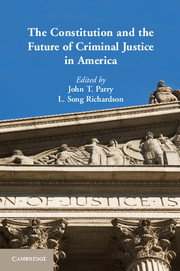Book contents
- Frontmatter
- Contents
- Contributors
- Acknowledgments
- Introduction
- Part I Foundations – The Scope of Criminal Law and Access to Counsel
- Part II Race and Criminal Procedure
- Part III Policing and Privacy
- Part IV Technology and the Surveillance Society
- 8 Information and Social Control
- 9 Is the Fourth Amendment Relevant in a Technological Age?
- Part V Confessions and miranda
- Part VI Conviction, Sentencing, and Incarceration
- Part VII Emergencies and Borders – Immigration, Terrorism, National Security, and Transnational Crime
- Index
- References
9 - Is the Fourth Amendment Relevant in a Technological Age?
Published online by Cambridge University Press: 05 June 2014
- Frontmatter
- Contents
- Contributors
- Acknowledgments
- Introduction
- Part I Foundations – The Scope of Criminal Law and Access to Counsel
- Part II Race and Criminal Procedure
- Part III Policing and Privacy
- Part IV Technology and the Surveillance Society
- 8 Information and Social Control
- 9 Is the Fourth Amendment Relevant in a Technological Age?
- Part V Confessions and miranda
- Part VI Conviction, Sentencing, and Incarceration
- Part VII Emergencies and Borders – Immigration, Terrorism, National Security, and Transnational Crime
- Index
- References
Summary
Introduction
The year is 2015. Officer Jones, a New York City police officer, stops a car because it has a broken taillight. The driver of the car turns out to be a man named Ahmad Abdullah. Abdullah’s license and registration check out, but he seems nervous, at least to Jones. Jones goes back to his squad car and activates his Raytheon electromagnetic pulse scanner, which can scan the car for weapons and bombs. Nothing shows up on the screen. Nonetheless, he takes down Abdullah’s Vehicle Identification Number, which he hopes can facilitate tracking the car’s public travels, using signals sent by the car’s factory-installed transponder to New York’s Intelligent Transportation System (ITS) computers.
Over the next several weeks, New York police do precisely that. They also observe Abdullah taking walks from his apartment, relying on public video cameras mounted on buildings and light poles. When cameras cannot capture his meanderings or he takes public transportation or travels in a friend’s car, the police monitor him with drone cameras, powerful enough to pick up the numbers on a license plate. Police interest is piqued when they discover that he visits not only his local mosque but several other mosques around the New York area. They requisition his phone and Internet service provider records to ascertain the phone numbers and e-mail addresses of the people with whom he communicates. Through digital sources, they also obtain his bank and credit card records. For good measure, the police pay the data collection company Choicepoint for a report on all the information about Abdullah that can be gleaned from public records and Internet sources. Finally, since Abdullah tends to leave his windows uncurtained, police set up a Star-Tron – binoculars with night vision capacity – in a building across the street from Abdullah’s apartment so they can watch him through his window.
- Type
- Chapter
- Information
- The Constitution and the Future of Criminal Justice in America , pp. 152 - 166Publisher: Cambridge University PressPrint publication year: 2013



